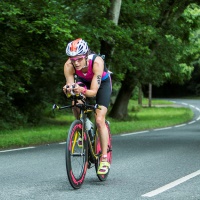-
The importance of bike fit for a triathlete
- Posted onjofrancis
- in Cycling, Masters Article Library
- onApril 30, 2015
- No Comments.
by Duncan Scott
 The ability to run well ‘off the bike’ is crucial to triathlon. As well as the physical conditioning and determination required to achieve this, there is another factor which can make a real difference to the athlete’s success – the bike position.
The ability to run well ‘off the bike’ is crucial to triathlon. As well as the physical conditioning and determination required to achieve this, there is another factor which can make a real difference to the athlete’s success – the bike position.It is very important for the ambitious triathlete to understand the theory behind optimal bike position before trying to achieve such a position either on their own, or with the help of a bike fitter. Keep in mind that not all bike fitters understand the rigours of triathlon, or appreciate the subtle differences between it and time-trialling.
A simple way to understand optimal bike position for triathlon is to look at how a triathlon specific bike differs from both a traditional road bike and from a time-trial set-up. This is especially important if you intend to fit tri-bars to a road bike or if you are choosing a tri-specific bike.
Tri-specific bikes may make a lot of show in terms of their weight and aerodynamic profile, but the important differences lie elsewhere in two crucial areas. Firstly steeper seat tubes and multi-position saddles allow the rider to get much further forward in relation to the bottom bracket. Secondly longer head tubes allow for more elevated arm rests and handlebars. A new shorthand for measuring the crucial dimensions of tri bike frames has been developed – ‘stack’ refers to the height difference between bottom bracket and top of head tube, while ‘reach’ refers to the horizontal difference between the same two points. This data allows you to compare multiple frames across different manufacturers in terms of whether a frame is relatively tall, but compact, or low and long.
So you now know how a tri-specific bike differs from a traditional road bike, but perhaps not why. Let’s start up front – the slightly longer head tubes found on modern tri-bikes allow for a sensible and sustainable torso angle. This is somewhat less aggressive than the lower ‘cockpits’ found on all- out time-trialling bikes. Seen from the side-on, only the strongest athletes can achieve a totally flat-backed profile while still breathing efficiently, and looking ahead at the road for many hours. For the vast majority, it is far more sensible to raise the front end to a comfortable level. At this point, there is a link between ‘up front’ and ‘saddle position’. As well as the height of the tri-bars (based upon stack), it is important that the athlete can comfortably reach them (based upon reach) – the upper arm should drop as close to vertically as possible, and the forearm should be supported by the tri-bars as close to the elbow as possible. There is a limit to how far back we want to place the tri-bars relative to the head-tube, so this means we want the saddle to be in a place which means the athlete doesn’t have to stretch to reach the tri-bars. Happily, the tri-specific bike rotates the seat tube forwards which brings the saddle position closer to the cockpit (shorter reach) and has the effect of opening up the hip angle. If you look at recent photos of the top long-course pros (Tim Don is a great example) you will see exactly what this looks like – the latest positions are compact and upright relative to even the recent past – the athlete is neither too low at the front, nor seated too far back, both of which contribute to a more open hip angle and consequent better performance.
All of this should tell you that it is actually quite difficult to achieve an optimal triathlon position by attaching tri-bars to a road bike. A compromise can be achieved by moving the saddle as far forward as possible and by using tri-bars (such as Profile T2) which can be set up with the arm-pads well behind the handlebars. Both of these will impact the handling of the bike and it is vital that the athlete practices safely until he or she is comfortable on such a set-up.
If you are in any doubt at all, then just drop me a note and we can into this more detail.
If you enjoyed this article please consider sharing it!




